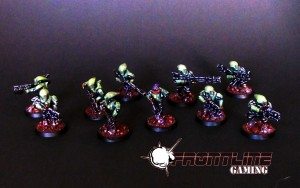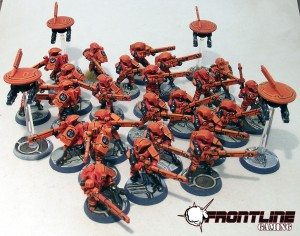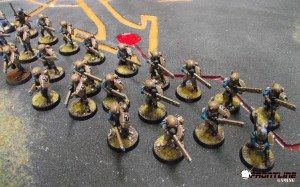Hello once again, and welcome back to Tactics Corner. This time around we’re talking about the good ol’ reliable Tau troop choice that dates back to the inception of the codex largely unchanged, the Strike Team.
Overview
The Strike Team, formerly simply called “Fire Warriors,” are the nominal basic troop of the Tau codex, though in practice they are often superseded by Crisis Suits, Kroot Carnivores, or Breacher Teams. However, that isn’t to say they don’t have value- Strike Teams are quite good at putting out medium-strength firepower at the middle ranges and have gained a couple handy tricks with the codex update. They remain relatively vulnerable to enemy fire, though, which tends to limit their usefulness in tournament settings where extreme firepower abounds.
Strike Teams get a fairly generic non-Marine statline with no real surprises; threes across the board are the rule in most cases, dipping down to twos in Weapon Skill and Initiative because of being Tau. This means that their basic accuracy is middling, as their shots only hit on a 4+ without the aid of Markerlights- but of course any Tau army worth its salt brought those in abundance. Leadership 7 means they are quite likely to panic and run the moment anything goes wrong, so unless there’s an Ethereal in range you shouldn’t count on them sticking about. 4+ armor isn’t quite MEQ quality, but can shrug off a surprising amount of damage in many cases; beware those Heavy Flamers, though.
The biggest point in favor of the Strike Team is its main armament, the Pulse Rifle. With a 30″ range, S5 AP5 and Rapid Fire it is strictly superior to the common Boltgun in almost every regard; it not only wounds basic troops on 3s and 2s, but is twice as effective against most Monstrous Creatures and can potentially even hurt a Wraithknight as well as damage transports like a Rhino. Many of these are unreliable things at best, but there is a world of difference between having some chance of hurting a target and having no chance at all. Strike Teams also come equipped with Defensive Grenades, which mitigate damage in close combat slightly and can potentially Blind enemies at short range, though this rarely works particularly well. However, if you’re facing some Necrons or a Stormsurge, then throw that shit, brah!
They are also allowed to swap their Pulse Rifle for a Pulse Carbine (18″ S5 AP5 Assault 2 Pinning), but this is almost never a good option. With the changes to Rapid Fire since 5th edition, the Rifle gets its second shot almost the same time that the Carbine starts getting any shots and can begin firing much earlier- important on a unit that doesn’t really want to be getting charged and doesn’t have the raw damage output (e.g. Eldar Bladestorm weapons) to clear out most things in a single volley. While Pinning is a nice addition, many unit types are immune to it and Tau have no way to penalize enemy Leadership unless they bring in Eldar or Dark Eldar allies, so it’s of very limited effectiveness. If you want a short-range high-firepower answer, just take a Breacher Team instead of swapping guns.
Special Rules, Wargear, and Options
Strike Teams come with a small handful of rules and options; Supporting Fire is the most notable of these, allowing you to coordinate shots against assaulters; it won’t usually stop a charge except perhaps at long range, but it can inflict some attrition on the enemy and perhaps slow them down a bit. They can increase their squad size up to twelve members if they wish, at 9pts per body; they can also upgrade one member to a Shas’ui for +1 Leadership and Attacks (?!?) if they want, as well as the option to add a pair of Drones to the unit if they do so.
However, most of the more relevant upgrades focus on filling the gaps in the Strike Team’s capabilities, namely anti-tank. Prior to 7th Edition Tau simply had no options in this arena, but the addition of the DS8 Turret has done a good job of answering that issue. The Turret’s rules are rather odd and a bit counterintuitive; you can place it if the unit chooses not to move and put it within 2″ of any squad member. The Turret can’t be attacked or harmed directly, but vanishes if the enemy gets within 2″ of it or if its squad moves out of this range (though a new one can be set up later, using the above rules.) Whenever the unit shoots, it can pitch in and add its own firepower- either a Missile Pod (S7 AP4 Assault 2) or Smart Missile System (S5 AP5 Heavy 4 Ignores Cover/LOS). While both are excellent weapons- and, interestingly enough, the only instance where a SMS is not twin-linked- the Missile Pod should virtually always get the nod because it gives them a wholly new capability they otherwise lacked. We should also take this moment to point out that since the Turret can’t be shot at (but can itself shoot), a Strike Team positioned behind terrain so as to be unseen can sneak a Turret around a corner or such and have it fire away at the enemy while being invulnerable.
The Turret isn’t a mandatory inclusion by any means, but can be very helpful to Strike Teams that intend to stay relatively static; for those on the move, Haywire Grenades (or EMP Grenades, as the Tau term them) can also give an option, albeit a bit expensive of one. But they can provide some minimal capability at short ranges if needed, so they are worth at least thinking about sometimes.
Strike Teams can also take a Devilfish as a dedicated transport; while the Devilfish isn’t a fantastic tank, it’s somewhat passable and can do a good job of keeping its contents alive, which is often all you’re asking of Tau troops. However, it can be a big increase to the sum cost of the unit, so it can’t be regarded as mandatory (and doesn’t sync well with many of the upgrades, like DS8 Turrets and EMP Grenades.)
Uses
The Strike Team is very much a glass cannon unit; it can put out a pretty significant amount of firepower for a fairly small price, but it is utterly incapable of weathering any such return damage and indeed can fall to pieces from the most trivial amount of attention from the enemy. As a result, one must be extremely careful when using them to always be aware of what sort of firepower can focus on them and what the rest of your army is doing.
The Pulse Carbine’s range can be one way to mitigate the fragility of the unit- if they aren’t within 24″ of enemy basic troops, they can’t be shot at. Obviously this isn’t always 100% possible, but limiting their exposure via range is one big step towards keeping them alive. Beware the enemy’s dedicated anti-infantry weapons like Scatter Lasers and Quad Mortars, though, as these heavier weapons can often reach out and hit you almost no matter where you are.
Strike Teams on foot are often run as minimum squads of five in order to cheaply fill a Troop slot; these basic units can provide a lot more firepower than one might think due to their S5 guns and relatively long reach for Rapid Fire (15″ + 6″ move), but the caveats about fragility are especially important for these units. Larger squads can also be of use- I have often run full squads of twelve (or occasionally just nine, for morale purposes) with an attached Cadre Fireblade or Ethereal. These characters allow you to vastly increase the output of firepower for the unit- the full unit plus Fireblade nets you over twenty-five shots at anything within your (not-insignificant) reach and both units get you nigh-on forty shots when Rapid Firing. Even a single Markerlight hit will turn these units into extremely effective anti-infantry platforms that can sit on or near an objective to score it for you.
As mentioned in the Fireblade article, the foot units like this can make an excellent ally choice as they are relatively cheap and put out a type of firepower that many armies can do with. Especially in situations where you can expect to face some Ignores Cover firepower that will shred Kroot badly, a Strike Team can fill the mandatory slot while still bringing something helpful to the table.
The “Fish of Fury” tactic (i.e. mounting a Strike Team in a Devilfish and unloading them near the enemy to do a lot of damage) is usually done more with Breacher Teams these days, but you can still get some mileage out of it. Many opponents will assume that if they get within range of an assault, the unit is dead- however, you can preempt this by unloading the Strike Team behind the ‘Fish and then cramming it right up on top of the would-be assaulters. As the Devilfish sits on a flying base, the Strike Team should easily be able to see underneath it and both squad and transport (plus the onboard Gun Drones) can combine shots on the enemy and do some damage; come the enemy turn, they will probably be forced to assault the Devilfish, incurring a round of Supporting Fire from the ex-passengers even if they do manage to wreck it. It’s not something that will devastate full-strength enemies, but it’s excellent for finishing off something that has been harassing you for a couple of turns. This ability to unload, shoot, and then likely survive the enemy’s counterassault after is what differentiates them most from Breacher Teams; where Breachers commit themselves absolutely to an alpha strike once disembarked, Strike Teams have a bit of leeway in how and where you place them.
Strike Teams, as a basic troop, are available in a number of different formations for Tau; they aren’t exceptional in any of them, as they tend to fill a “I’m here also” sort of role in a lot of armies. A Hunter Cadre is one of the most notable of these, since they can use Combined Fire to not only boost their own Ballistic Skill (making their guns a lot more effective) but also help out other units in the army significantly- their long range and ability to contribute to a shot while staying out of sight (thanks to the DS8 turret) makes them an ideal third unit for a combined shot.
Conclusion
Like many of the Tau units, Strike Teams are a fairly acceptable choice for many armies, even if they may not be a top-tier competitor. Though the massed units of Fire Warriors on foot that GW often tries to promote (in the fluff and in pictures) are laughably bad, more singular squads brought in the right armies can be functional and transport-mounted squads compare favorably with Breachers in many situations. They work well enough as a line troop and their sniping with DS8 turrets can make them very annoying to opponents who are otherwise occupied with trying to kill more important units to blunt your firepower.
Remember, you can pick up your plastic soldier fix from Frontline Gaming at up to 25% off every day, whether you’re looking to round out your collection or start a new army.





Great review as always, AP.
I have always wanted to make a Fire Warrior heavy Tau army, you think it is viable?
For the top tables at tournaments I don’t really think they can hold their own but they have amazing potential and don’t pull punches against even some killer lists.
My current Fire Warrior heavy list consists of a Hunter Contingent with Dronemander, + Fire Blade. 3x Ion Crisis Suits, 3x Plasma Crisis Suits, Riptide, 3 units of 5 pathfinders, 3 lone Broadside units, 2 units of 12 FWs, 2 units of 9 FWs, 2 units of 6 FWs, and the cheap drone network aux. Also has a CAD with an Ethereal and 2 lone Fusion Crisis Troops because of Farsight Enclave.
Basically the Fire Blade and Dronemander give the Hunter Cadre units run and shoot which keeps them mobile and RAW the extra shots from the Fire Blade works as well as heavy weapons still fire at full BS (rule for heavy weapons stats moving in the movement phase causes snap shots, says nothing about running and shooting). The Ethereal basically plays the shell game bouncing between units as they take casualties and hides behind LOS blockers. The Ethereal’s Ld 10 aura as well as his bonus rapid fire range shots, Stubborn, or even the dinky 6+ FNP are extremely beneficial to the army. Deep Strike in the Crisis to threaten the enemy flanks and rear while the FW blob is decently mobile and attempting to charge into them turns in insane overwatch (i had overwatches that rivaled some of my shooting phases).
The secret sauce for Fire Warriors is the Ethereal as he fixes the biggest issue with Tau infantry which is leadership. The Hunter Cadre makes them mobile (start to look like Eldar infantry out there at times) and the best part is that they are cheap. They can fight like guardsmen but their guns are actually going to hurt things unlike the Emperor’s Flashlights. Its not an easy list because people HUNT for that Ethereal like its no tomorrow but protect him with everyone’s lives and your Greater Do-Gooders will fight on until the bitter end and then some. Also Fire Warriors are effective in the Hunter Cadre as each model individually is just as effective as a full strength squad. Before they would become inefficient to boost with markerlights when their numbers dwindled but now they combine fire and can assist in other units shooting with full marker effect even if you have units with only 1 or 2 guys left. Just to point out as well, 12 FIre Warriors and 3 Crisis Suits are equally durable to bolter fire and have equal fire power to those 3 Crisis Suits armed with burst cannons for a lower points cost (for what thats worth).
Like i said Fire Warrior lists aren’t going to magically turn the meta upside down or anything but they do pack a mighty punch for a low price point. Biggest weakness is that they can’t really get out there and contest objectives so they tend to play the “kill first and grab objectives later” game and lack mobility. Units like Crisis Suits and Riptides tend to get into the enemy lines more while the Fire Warriors fight to control the middle and provide support where needed.
Thanks for the in depth reply! Good data in there. I agree with your analysis, too. They have a good DPS for their points, but lack durability. With overlapping special rules hopefully they can last long enough to make a meaningful contribution.
It is, however, great fun putting 72 firewarriors down and engaging with a marching gunline. As stated, the sheer shenanigans and USR bloat many armies seem to be able to tack onto their units means they won’t fare very well, but it does make people pause more often than not.
Yeah, so much firepower! Plus I love the models. Always wanted to try it but humorously the army I would fear the most would be other Tau with the boatloads of AP4, ignores cover shooting they put out, haha
If they draw meaningful fire, deal some damage shooting, and/or absorb charges then they have done their job for me. Most of the time the enemy has to get closer to the Tau so they form layers of defense for the more meaty targets like Broadsides which buys time for all my units to deal damage to the enemy. Very rarely do I find my Fire Warriors didn’t contribute in some meaningful and semi cost effective way to the total battle plan. Fire Warriors form the anvil of my army while the Crisis Suits are the hammer blow that breaks the enemy (and sometimes you just gotta pick up the anvil and throw it at them and let the raw weight/firepower do the work lol.
Artillery armies are the big thing that really scares me as they can really outrange the Tau and tend to have massive firepower. Tau vs Tau as you said in a different response would also be scary (but interesting). Deathstars as always are a royal pain but sometimes having mass volume of fire can be good for chipping away at them (pray to the dice gods that they roll a lot of 1s).
As mentioned in the article, in Devilfish they’re pretty acceptable- especially when you can get a cluster of them working in tandem with each other. Three units of nine Rapid Firing into the enemy can cause some damage.
If you’re trying to work them on foot, I think you have two route you can go- either a “pure” foot army or one based around using the Tau “drift” fortifications. The terrain on a lot of tables makes use of them prohibitive in many cases, but if you can reach a gentleman’s agreement with your opponent allowing you to re-orient them where needed and/or pass onto or over other terrain pieces, I feel like they’re a pretty solid buy.
If you go the all-foot route, I think Vankraken mostly has the right idea- you want 4-6 medium-sized units of Strike Teams with support from Ethereals and possibly Cadre Fireblades. The Hunter Cadre’s bonuses are pure gold for FW, since they give you the mobility you lack and Combined Fire means you don’t need to use many, if any, Markerlights on the units. I would go a different direction from him, using my Commander + Crisis to serve as vehicle-hunters (Missile Pods, Puretide Chip, etc), but the Broadsides are also going to be very clutch. Pathfinders, although they fit the theme well, are just not going to be a very good unit because they share all the same weaknesses as Strike Teams do; I would aim for Sniper Drones or other sources of Markerlights instead. I also think at least one good-sized (16+) Kroot unit would help a lot by giving you a one-turn respite from assaulters- with as many guns as the list would have, that volley of Supporting Fire followed by your next turn’s shooting will often seal the deal. And remember you can Support to 12″ with the core formation!
If you are trying to make the fort-based one work, I feel you have a lot more options. Broadsides and other “immobile” units suddenly can start moving again and the protection from the shields can be surprisingly scary, especially to vehicles- 1/6 chance per successful save to cause a glancing hit will give many of them second thoughts about firing at you, especially high-RoF platforms like LR Punishers or Gattling Knights. A Combined Arms detachment would be much preferable as your main source here, since not only does it give you the fort slot but it also gives you better access to the HQs you want (not to mention many of the snazzy Forge World units.) I think Pathfinders are a lot more acceptable in this variant, though in the end I still might prefer Sniper Drones (though that’s possibly just because I like them so much.) Some Tetras, Piranhas, Kroot, or allied units to give you a little bit of mobility and firepower diversity and you’d be well on your way to a functional, if not tournament-winning army.
My list is just an example of something I use for fun but it does work decently well. Pathfinders are by no means ideal units but what they do have going for them is just being cheap MSU style units (plus you need at least 1 fast attack unit in the Hunter Contengent). Other sources of markerlights would probably be a lot more effective than pathfinders so I wouldn’t argue against replacing them.
What I like about having the Commander to escort markerdrones is that he can tank for a markerlight source and stick with the Fire Warrior units to provide that 12″ run and shoot bubble. The Fire Blade also provides this 12″ bubble as well so they’ve can cover each side of the group so basically everyone can run and shoot. I tend to rely on Crisis with Cyclic Ions (such a good weapon) or Fusions to tankbust which means any escorting commander will be away from the main force and not providing the bulk of the force run and shoot. Crisis Suits tend to get killed quickly so I like to keep them lean and expendable. Thats just how I tend to run them but buffmander on a unit with a lot of target lock can be incredibly deadly and I’ve seen that clear entire IG backfield motor pools in a turn of shooting.
Commander + Drones isn’t a bad unit, I’ve used it lots of times, but I would feel in a list like that which has a lot of anti-infantry but not a lot of anti-tank I’d want some extra “oomph” there. I tend to use Piranhas to fill my “FA slot” in the Hunter Cadre, since they benefit a LOT from the Commander’s ability to let them Flat Out and then shoot- with Fusion, they are practically guaranteed double penetration any time you want it, and it’s easy to get them to BS4 or 5.
Ion is definitely a nice weapon, though, no disagreement there. I need to use it more, but I just love that 36″ on a Missile Pod too much. >.>
Flat out and shoot with Fusion Piranhas…. That sounds amazing and definitely something worth trying out. Some potential turn 1 melta threat that isn’t deep strike reliant is awesome.